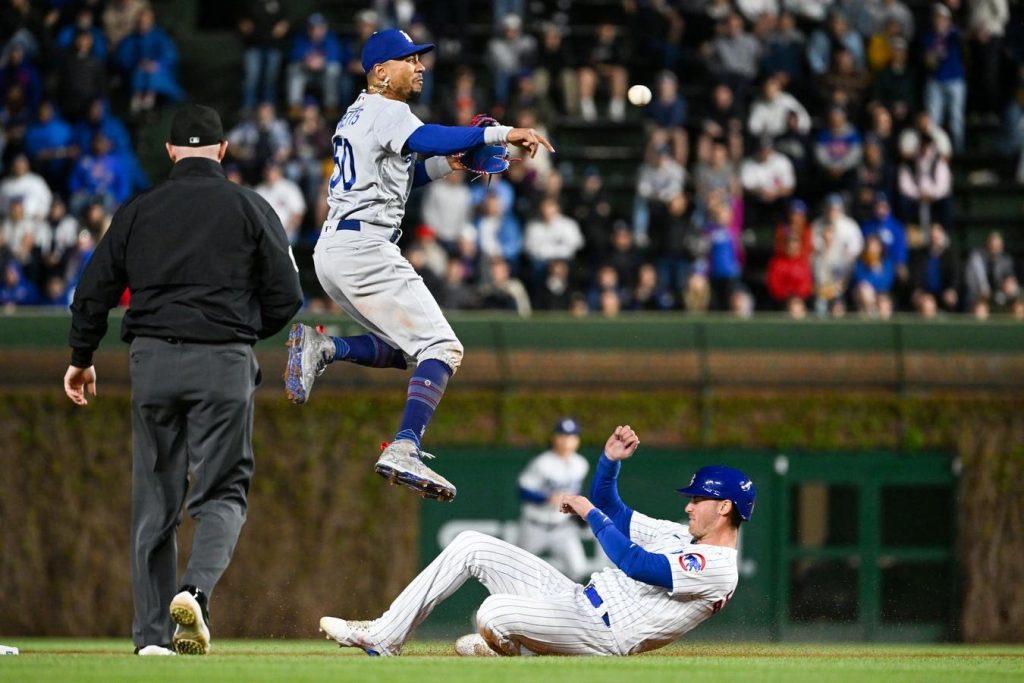CHICAGO, ILLINOIS – APRIL 20: Mookie Betts #50 of the Los Angeles Dodgers turns a double play in the … [+]
Getty ImagesThe Los Angeles Dodgers made one of the biggest splashes on the first day of the MLB Winter Meetings—not with a trade or signing, but with an announcement. During an MLB Network interview, manager Dave Roberts told the world, “It’s pretty safe to say that number 50, Mookie Betts, is going to be our everyday second baseman.”
Betts, the 31-year-old runner-up for the MVP award, is undoubtedly one of the best all-around players in the sport. Even though he came up as a middle infielder with the Boston Red Sox, he has spent the majority of every big-league season in the outfield. Six Gold Gloves as a right fielder decorate his trophy case.
After playing only 30 games as an infielder combined from 2014-2022, he spent 70 games at second base and 16 at shortstop in 2023. This was borne out of necessity—starting shortstop Gavin Lux suffered a knee injury in spring training and missed the entire season, thinning out their infield depth.
Advanced metrics graded his work at the keystone somewhere between average and good. According to defensive runs saved, he was worth six runs, but Statcast’s outs above average gave him a negative one rating at the position. It’s worth noting that both of these were equal to or better than his performance in right field (three defensive runs saved, negative one outs above average), indicating a decline at his normal position.
There are no questions about Betts’ prodigious bat, which will be even more valuable as a second baseman. His 167 wRC+ indicates that his offense was 67% better than an average player last year. The average wRC+ is always adjusted to 100, but it fluctuates for different positions. Right fielders across MLB had a 105 wRC+, whereas second basemen only had a 98. This indicates that right fielders are generally better hitters than second basemen, so it’s harder to find a good hitter in the middle infield than it is in an outfield corner.
Since Betts is versatile enough to start at either spot, the Dodgers’ internal options are an important factor. They recently re-signed Jason Heyward to a one-year, $9 million contract. The 34-year-old hit .269 with 15 home runs in 377 plate appearances last season, thriving in a platoon role that limited his exposure against left-handed pitching. At 34 years old, he’s not the outfielder he used to be, but he still has five Gold Gloves in right field and remains a capable defender.
Their options at second base aren’t as well-established—aside from Betts. Former prospect Miguel Vargas played 78 games there last season. He came up primarily as a third baseman through the Dodgers system and has questionable athleticism and instincts for the middle infield. More importantly, he only hit .195 with seven home runs in 304 plate appearances. Last month, the club indicated he could spend more time in the outfield, and a platoon with Heyward seems logical.
The Dodgers could sign or trade for a player to fill either role, but it’s much harder to come across a starting second baseman than it is a right fielder. The top free-agent second baseman according to MLB.com is Elvis Andrus, a 35-year-old 15-year veteran who only managed a .304 on-base percentage in 2023. There are probably 15-20 outfielders on the open market who were more productive.
The key word in Roberts’ comment is “everyday.” That could mean the Dodgers plan is for Betts to play all nine innings a second base at least 150 times. It’s also possible they use him at second against right-handed pitching and in right field against lefties. Perhaps he’ll play the first seven innings at second, then take over in right when they have a lead to make way for a yet-to-be-determined defensive replacement.
If Betts wasn’t willing and able to make this move, re-signing Heyward would’ve been less likely. His athleticism, versatility, and willingness to put the team first give the Dodgers plenty of options as they try to win the NL West for the 11th time in 12 years.
